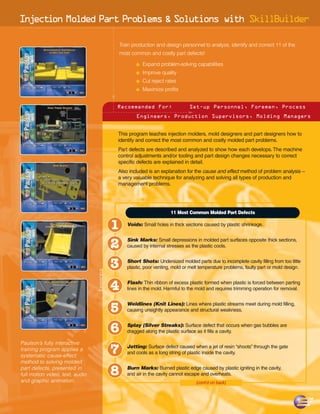Injection Molded Part Problems and Solutions
- 1. Inject on Mo ded Part Problems & Solutions with SkillBuilder i l Train production and design personnel to analyze, identify and correct 11 of the most common and costly part defects! N Expand problem-solving capabilities N Improve quality N Cut reject rates N Maximize profits Recommended For: Set-up Personnel, Foremen, Process Engineers, Production Supervisors, Molding Managers This program teaches injection molders, mold designers and part designers how to identify and correct the most common and costly molded part problems. Part defects are described and analyzed to show how each develops. The machine control adjustments and/or tooling and part design changes necessary to correct specific defects are explained in detail. Also included is an explanation for the cause and effect method of problem analysis – a very valuable technique for analyzing and solving all types of production and management problems. 11 Most Common Molded Part Defects 1 Voids: Small holes in thick sections caused by plastic shrinkage. 2 Sink Marks: Small depressions in molded part surfaces opposite thick sections, caused by internal stresses as the plastic cools. 3 Short Shots: Undersized molded parts due to incomplete cavity filling from too little plastic, poor venting, mold or melt temperature problems, faulty part or mold design. Lessons 4 Flash: Thin ribbon of excess plastic formed when plastic is forced between parting lines in the mold. Harmful to the mold and requires trimming operation for removal. 5 Weldlines (Knit Lines): Lines where plastic streams meet during mold filling, causing unsightly appearance and structural weakness. 6 Splay (Silver Streaks): Surface defect that occurs when gas bubbles are dragged along the plastic surface as it fills a cavity. 7 Paulson’s fully interactive Jetting: Surface defect caused when a jet of resin “shoots” through the gate training program applies a and cools as a long string of plastic inside the cavity. systematic cause-effect method to solving molded part defects, presented in full motion video, text, audio 8 Burn Marks: Burned plastic edge caused by plastic igniting in the cavity, and air in the cavity cannot escape and overheats. and graphic animation. (cont'd on back)
- 2. Injection Molded Part Problems & Solutions with SkillBuilder 11 Most Common Molded Part Defects (cont’d) 9 Warp: Molded part distortions from uneven stresses in the part caused by faulty molding conditions inside the cavities. 10 Cracks and Part Breakage: Weak molded parts susceptible to cracking and breaking, as a result of incorrect molding conditions that can cause five different types of cracking problems. 11 Controlling Molded Part Dimensions: Off-spec parts caused by dimensional changes throughout the part, in specific areas or directionally. SkillBuilder Lab Lessons for Injection Molded Part Problems & Solutions Solving a Burnmark Problem The purpose of this lesson is for the student to learn some of the available molding techniques that will help eliminate a burn mark on a molded part. Molding to Precise Dimensional Tolerances Conduct experiments using those machine controls which affect final part dimensions to lead the participant to a greater understanding of precisely controlling part dimensions. Controlling Flash on a Molded Part This SkillBuilder lesson explores all the possible solutions for eliminating flash on a molded part including, high or low melt and mold temperatures, high packing and holding pressures, unbalanced pressure distribution in the mold, parting line damage or too deep of a vent channel. Solving Sinkmarks on a Molded Part This will challenge the student to solve this problem in a variety of different ways. Both mold temperature and injection pressures are experimented with to demonstrate to the user more than one possible solution to the problem. Identifying and Solving Voids in Molded Parts Here the molder is allowed to adjust machine controls to create, then solve each problem. In this way a deeper understanding of the problem is realized. Minimizing Weldline Formation and Appearance The purpose of this SkillBuilder lesson is to show molding techniques on how to reduce and even eliminate the visual appearance of weldlines on a molded product. To sign up for a hands-on-I-T system demonstration in your plant, call Paulson Training Programs, Inc. 1-800-826-1901. 15 N. Main Street, PO Box 366, Chester, CT 06412 Phone: (860) 526-3099 e-mail: sales@paulsontraining.com www.paulsontraining.com

